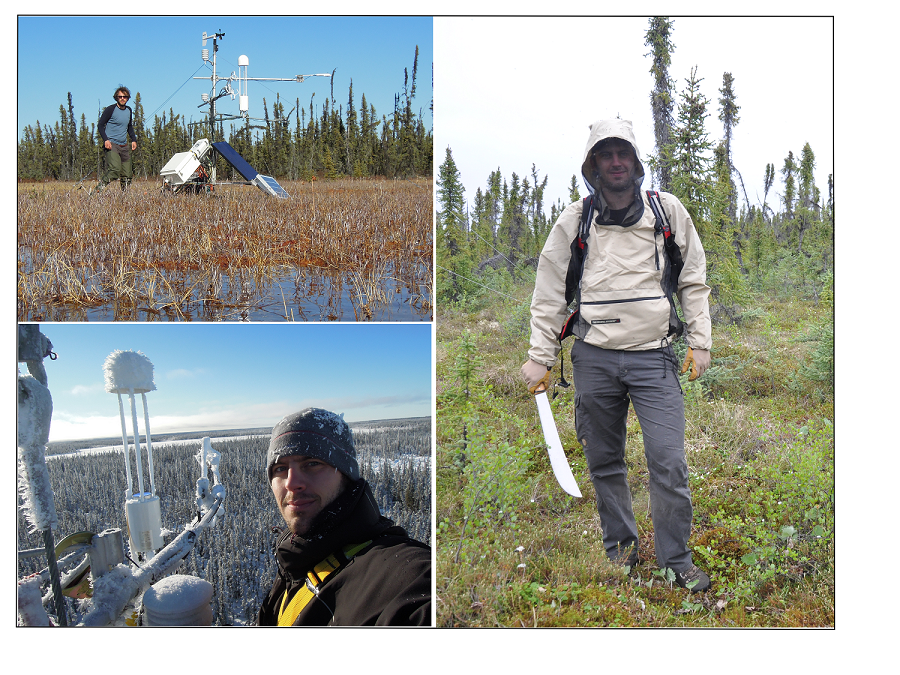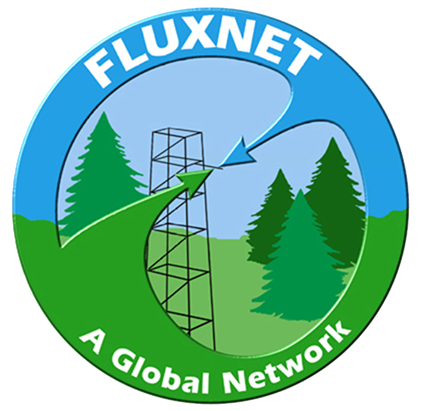This is the next in a line of periodic interviews with Fluxnet Young Scientists. This month, we’re glad to introduce Manuel Helbig, who is a 4th-year PhD student in Oliver Sonnentag‘s lab in the Université de Montréal, Canada. Manuel recently received an honorable mention in the Atmospheric Biogeosciences section and was awarded the Bert Tanner student prize for his talk at the AMS conference (link). More information on Manuel is available through his ResearchGate Link.

Since the beginning of my undergraduate studies seeing and experiencing with my own eyes how ecosystems function has mainly inspired my research. The drastic snowmelt changes in Arctic ecosystems, driving through a vast boreal wildfire, my first time in a lush tropical rainforest, experiencing a miserably cold July in the tundra, or digging soil in the steppe have taught me a lot about ecosystem diversity on Earth and sparked my interest in pursuing a scientific career.
I gained my first flux tower experience when I used the eddy covariance technique to measure water vapour fluxes for my Master’s research. For my thesis, I studied the hydrological impacts of permafrost thaw in a polygonal tundra environment in northern Siberia. In this context, I became more and more interested in micrometeorological measurement techniques and decided to pursue doctoral research in this direction. Having conducted my undergraduate and Master’s studies in Germany, I wanted to obtain a PhD degree abroad. At the Université de Montréal, I found a challenging research project assessing permafrost thaw impacts on land-atmosphere interactions. My current PhD research revolves around the difficulties of interpreting landscape eddy covariance flux measurements in a fragmented boreal forest-wetland landscape and the challenges of upscaling flux measurements to a larger regional context.
What is the focus of your research and what are your main findings?
In northwestern Canada and in Alaska, permafrost thaw causes widespread expansion of wetlands in organic- and ice-rich boreal forest landscapes. How such land cover changes alter land-atmosphere exchanges of energy and greenhouse gases is my main research question. I am also investigating how these changing land-atmosphere interactions may affect climate. Recently, we published a study in Global Change Biology showing that thaw-induced hydrology changes and shifts in vegetation structure and composition drastically affect how available energy is partitioned; water vapour fluxes increase at the expense of decreasing sensible heat fluxes, pointing to a regional atmospheric cooling and wetting effect. In contrast, our work on methane fluxes indicates that, at the current rate of permafrost thaw, landscape methane (CH4) emissions increase by about 0.5 % per year. In the course of this century, the observed small landscape CO2 sink is very unlikely to neutralize the climate warming effect of the increasing CH4 source. By looking at both biophysical and biogeochemical impacts, we could identify two contrasting land cover change impacts on climate. (Details refer to Helbig et al., 2016 GCB)
As you work more with flux data, what skills do you feel you need to acquire (either in the past or near future) to make your studies more effective?
During the past four years, I have learned how to use readily available earth observation (e.g., MODIS, SCIAMACHY) and paleoecological databases to support flux measurements. With these data, I was able to put my local-scale eddy covariance studies into a broader regional context. Personally, I was lucky to participate in three interdisciplinary summer schools in the U.S. and in Europe that sparked my interest in expanding my research beyond the flux tower footprint. For me, at first, technical skills appeared to be the biggest hurdle, but with the increasing availability of online manuals and tools downloading, processing, and analysing large datasets becomes easier. The critical understanding and interpretation of these data however was the most difficult task. Working with data that has been collected by others is fundamentally different from analysing your own data, when you’re involved in the entire QA/QC process. For the future, I would like to acquire more modelling skills. Combining eddy covariance flux measurements with flux modelling provides a powerful tool to test ecological hypothesis or to upscale local flux measurements to larger scales. I think these skills can be best acquired in a collaborative environment where modellers, ecosystem scientists, and micrometeorologists exchange ideas and share their skills.
Who have been your mentors and how have they helped you arrive at where you are today?
There were many important mentors guiding and helping me during my studies. During my Master’s, Lars Kutzbach at the University of Hamburg taught me the ins and outs of eddy covariance flux measurements and introduced me to the world of biogeochemistry. During my PhD studies, my advisor Oliver Sonnentag encouraged me to and supported me in broadening my horizon by combining flux measurements with remote sensing and modelling. Working with Ivan Bogoev and George Burba on testing open-path gas analyzers improved my understanding of the technical side of measuring eddy covariance fluxes. I realized that, to interpret flux measurements, a good knowledge of the limitations of your instruments might often be equally important to a profound knowledge of your site. This work also has shown me the importance of patience and endurance in research.
What resources do you think the flux networks or communities have provided or could potentially provide to help your studies or career?
Many new questions have emerged from my PhD research that could be addressed by analysing flux data across various ecosystems and climates. I am particularly interested in investigating direct ecosystem responses to climate change. Such questions can now be addressed with long-term flux time series becoming more and more available. The continued effort of the flux community to make these flux data freely and easily accessible had an important contribution to this development. For my postdoctoral research, I would like to make use of this vast resource to test ecological hypotheses and assess land-atmosphere interactions in a changing climate. Many micrometeorological studies require high-frequency atmospheric measurements (e.g., spectral analysis, testing new flux corrections), which are currently collected at flux tower sites, but are rarely readily available. With the access to larger storage capacities and more powerful computers, these data hopefully will be increasingly shared in the flux community.
Flux networks also provide a great opportunity to introduce undergraduate and graduate students to data-driven ecosystem science. In my scientific career, I had the most exciting and rewarding experiences when exploring the functioning of a new ecosystem through the eyes of a flux tower.
What are your career goals and aspirations?
I will graduate at the end of this year; so in the short-term I am seeking a postdoc position. For my postdoctoral research, I wish to continue working with flux data and to particularly look at ecosystem responses to a changing climate and its feedbacks to the climate system. I am very keen to further broaden my focus to combine flux measurements with ecosystem modelling and remote sensing. For me, working in a collaborative environment where ideas and skills are shared across disciplinary boundaries is an important criterion. During my career, I wish to not only engage students in climate change and ecosystem research, but also to spark the interest of the broader public. In the long-term, I am seeking for a faculty or research scientist position.
— Texts, photos & figures are provided by Manuel Helbig —
Other research by Manuel Helbig:
- Helbig, M., Wischnewski, K., Kljun, N., Chasmer, L.E., Quinton, W.L., Detto, M., Sonnentag, O. (2016) Regional atmospheric cooling and wetting effect of permafrost thaw-induced boreal forest loss. Global Change Biology: DOI: 10.1111/gcb.13348.
- Helbig, M., Pappas, C., Sonnentag, O. (2016) Permafrost thaw and wildfire: Equally important drivers of boreal tree cover changes in the Taiga Plains, Canada. Geophysical Research Letters 43: 1598-1606.
